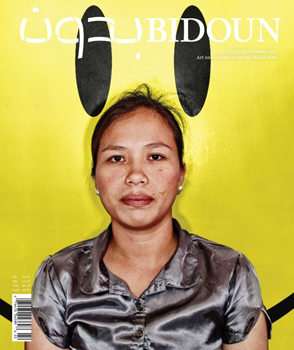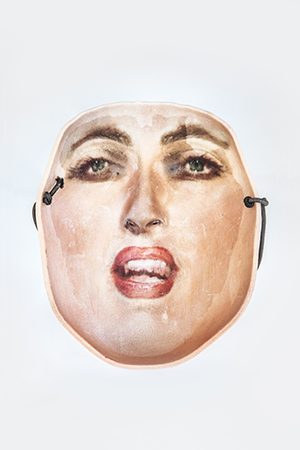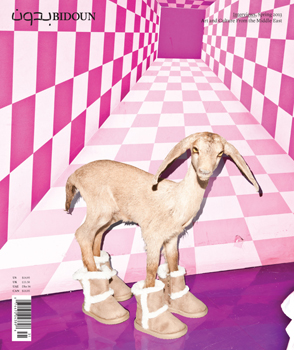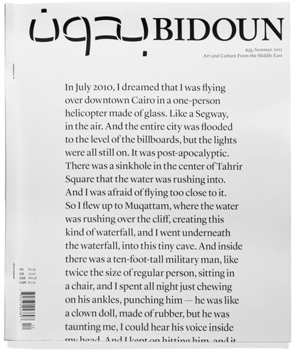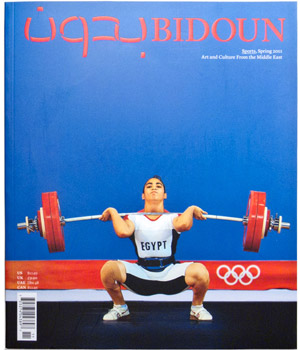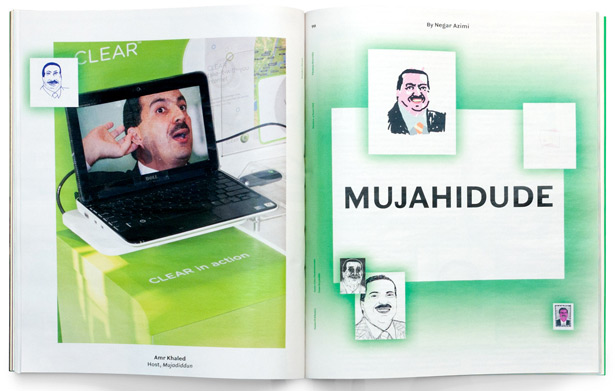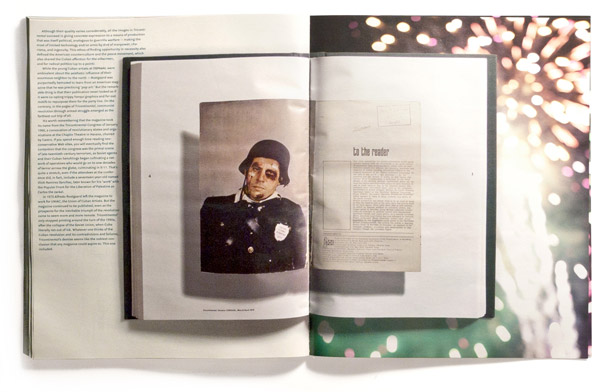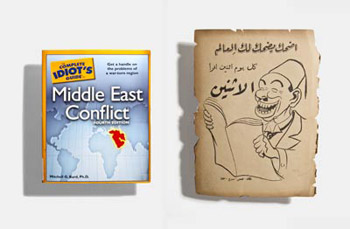Bidoun 27: Diaspora
For the diaspora artist—I use the term the way I would use “disappearing artist” or “trapeze artist”…
–Media Farzin, “The Imaginary Elsewhere”
For the DIASPORA issue of our New York–based Middle Eastern magazine, we wanted to treat the theme without sentiment; or at least, with a wider range of sentiments than the discourse of heritage (celebrate, defend) generally allows. We were interested in migrant culture—in informal economies and organized crime, in deracination and radicalization. We wanted to hear about what happens when Arab-Americans go Back to Arabia, and about the private lives of dispersed populations in the Middle East and elsewhere—Filipinos, Indians, Armenians.
Quite at home in the Armenian Library and Museum of America, the severed head of a young woman dangles by her hair a few feet from the reception desk. Two hands are holding her aloft: one bears a cuff with an Ottoman crescent and the date “1915,” the other a Nazi swastika and “1945.” Kevorkian’s own blood drips from the head and spills onto the painting’s frame, which is ringed by barbed wire.
–Anna Della Subin
In “A Very Still Life,” Anna Della Subin considers the curious case of Jack Kevorkian, pathologist, philosopher, assisted-suicide advocate, and convicted felon, whose gruesome and strikingly well executed paintings reside in the permanent collection of the premier Armenian heritage museum in Watertown, Massachusetts. Subin describes how the child of genocide survivors became the media celebrity known as Dr. Death, and the ambiguities inherent in memorializing catastrophe.
People just emphasized that Persian aspect of him because they always do that with artists from other parts of the world. It’s just the thing to do. Why should he stand up and say, “Oh, no, that’s not true.” Let them say what they want to say…
–Salar Abdoh on his brother, the late avant-garde theater director Reza Abdoh
When Reza Abdoh died of AIDS in 1995, aged thirty-two, his obituarists could agree that his work was controversial. Other facts proved more elusive. Born in Tehran, schooled in Britain, exiled to Los Angeles after the Iranian revolution, Abdoh had insisted that his mother was Italian, and did not demur when friends and critics divined Persian influences in his multimedia theatrical experiments. In “Imprisoned Airs,” Reza’s brother, the novelist Salar Abdoh, discusses his brother’s conflicted response to American multiculturalism with critic Daniel Mufson. A related inquiry into the wages of diversity takes place in “Model UNESCO,” a virtual roundtable discussion on the 2010 International Cairo Biennale, when a quartet of Arab-American women artists were sent to represent the United States, and a group of Egyptian artists and critics revolted.
There is a body of cinema about life in the Gulf, that is consumed by the majority of the population of the Gulf, that requires no special pleading or state subsidy to exist. Call it Gulfiwood: the popular culture of the Arab working class, most of whom happen to be Indian.
–Sudarshan Purohit
Other essays travel further afield in time and space. In “Aliens,” Darryl Li reports from Sarajevo, where Arab volunteers who fought alongside the Bosnians in the Yugoslav Wars of the 1990s languish in an immigrant detention center, unlikely casualties of the War on Terror. In “Gulfiwood,” Sudarshan Purohit travels to Kozhikode, the birthplace of Home Cinema—the low-budget Malayalam-language movie industry, one of the main pop-culture products consumed by South Asian laborers in the Gulf. In “The Imaginary Elsewhere,” Media Farzin reflects on identity fetishism and diaspora art. And in “Aleph Null,” Alexander Keefe reconstructs the life, death, and disappearing of Shridhar Bapat, an Indian expat in New York who became the first video curator at The Kitchen.
All this, plus Kate Sutton’s profile of Jumana Manna and her eros-tinged video art, discussion of new work by Rokni Haerizadeh and Vishal Jugdeo, new contributing editor Sukhdev Sandhu on the Otolith Group‘s meditation on poet and artist Etel Adnan, a host of reviews, and original photography by Adam Amengul, Jason Nocito, Ara Oshagen, and Veejay Villafranca.
For more, visit www.bidoun.org/27-diaspora
